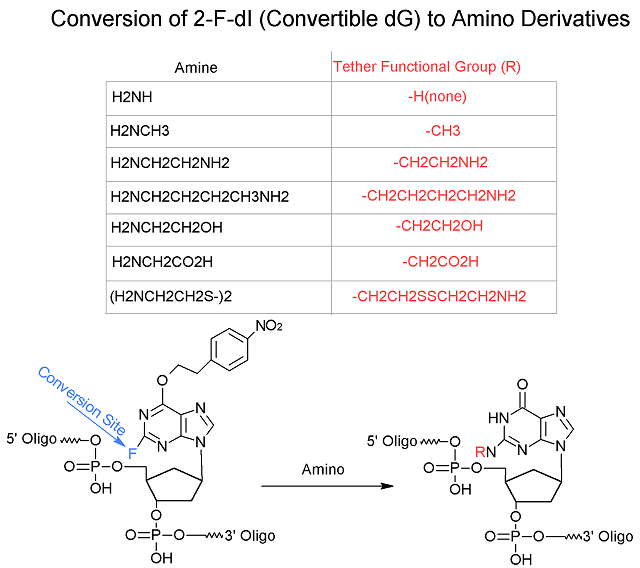.png)
Modification : Convertible dG (2-F-dI)
Catalog Reference Number
Category
Modification Code
5 Prime
3 Prime
Internal
Molecular Weight (mw)
Extinction Coeficient (ec)
Technical Info (pdf)
Absorbance MAX
Emission MAX
Absorbance EC
| Catalog No | Scale | Price |
| 26-6671-05 | 50 nmol | $489.00 |
| 26-6671-02 | 200 nmol | $489.00 |
| 26-6671-01 | 1 umol | $676.00 |
| 26-6671-03 | 2 umol | $758.00 |
| 26-6671-06 | 5 umol | $2,272.50 |
| 26-6671-10 | 10 umol | $4,044.00 |
| 26-6671-15 | 15 umol | $5,054.00 |
| Discounts are available for Convertible dG (2-F-dI)! |
| Modification* Discount Price Structure |
|
1 site/order
|
List price
|
|
2 sites/order
|
10% discount
|
|
3 sites/order
|
20% discount
|
|
4 sites/order
|
30% discount
|
|
5-9 sites/order
|
50% discount
|
|
10+ sites/order
|
60% discount
|
|
*Exceptions apply
|
Gene Link supplies Convertible modified oligos protected with oligo bound to CPG solid support or can conjugate the convertible site to user specified ligand.
2-Fluoro-deoxyinosine (2-F-dI) is classified as a convertible dG nucleotide. After incorporation into an oligo, reaction of the 2-fluorine on the inosine base with a primary amine displaces the fluorine atom, and converts the nucleotide into a N2-substituted dG. Oligos containing 2-F-dI modifications are useful precursors in studies requiring cross-linking, at G position(s), between oligos, or between an oligo and an enzyme. For example, 2-F-dI modified oligos have been reacted with disulfide-containing diamines (1) or thiopropylamines (2) in order to subsequently form disulfide-crosslinked DNA duplexes. Such oligos have also been reacted with bis-(3-aminopropyl)disulfide dihydrochloride, and the disulfide-containing oligo intermediate coupled to a short-lived HIV-1 reverse transcriptase kinetic intermediate to form stable enzyme-oligo complexes. The ability to synthesize such complexes have enabled deeper study of the DNA translocation mechanism of HIV-1 RT (3).
In order to minimize the possibility of unwanted side reactions with the exocyclic amines of other bases of the oligo, it must be fully protected and still attached to the synthesis solid support when reacted with the primary amine. Consequently, for customers ordering 2-F-dI-modified oligonucleotides, Gene Link supplies the oligo attached to a solid support for subsequent conversion to the appropriate N2-modified dG by the enduser.
See examples below of Convertible dG (2-Fluoro deoxy inosine) to various amino derivatives.

Protocol for conversion of 2-FI (convertible G) to the appropriate N2-modified dG.
References
1. Erlanson, D.A.; Chen, L.; Verdine, G.L. DNA Methylation through a Locally Unpaired Intermediate.
J. Am. Chem. Soc. (1993),
115: 12583-12584.
2. Erlanson, D.A.; Glover, J.N.M.; Verdine, G.L. Disulfide Cross-linking as a Mechanistic Probe for the B<-->Z Transition in DNA.
J. Am. Chem. Soc. (1997),
119: 6927-6928.
3. Sarafianos, S.G.; et al. Trapping HIV-1 Reverse Transcriptase Before and After Translocation on DNA.
J. Biol. Chem. (2003),
278: 16280-16288.
- Convertible dG (2-Fluoro deoxy inosine)
